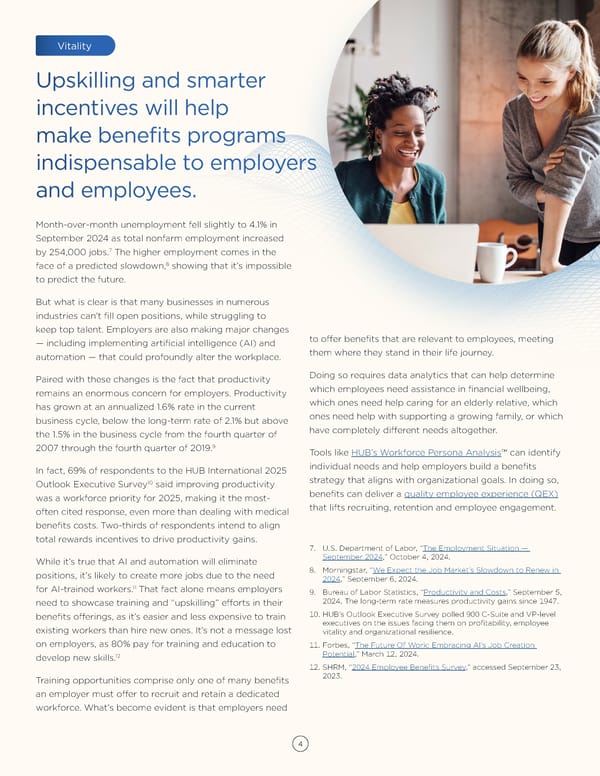Vitality Upskilling and smarter incentives will help make benefits programs indispensable to employers and employees. Month-over-month unemployment fell slightly to 4.1% in September 2024 as total nonfarm employment increased 7 by 254,000 jobs. The higher employment comes in the 8 face of a predicted slowdown, showing that it’s impossible to predict the future. But what is clear is that many businesses in numerous industries can’t fill open positions, while struggling to keep top talent. Employers are also making major changes — including implementing artificial intelligence (AI) and to offer benefits that are relevant to employees, meeting automation — that could profoundly alter the workplace. them where they stand in their life journey. Paired with these changes is the fact that productivity Doing so requires data analytics that can help determine remains an enormous concern for employers. Productivity which employees need assistance in financial wellbeing, has grown at an annualized 1.6% rate in the current which ones need help caring for an elderly relative, which business cycle, below the long-term rate of 2.1% but above ones need help with supporting a growing family, or which the 1.5% in the business cycle from the fourth quarter of have completely different needs altogether. 9 2007 through the fourth quarter of 2019. Tools like HUB’s Workforce Persona Analysis™ can identify In fact, 69% of respondents to the HUB International 2025 individual needs and help employers build a benefits 10 strategy that aligns with organizational goals. In doing so, Outlook Executive Survey said improving productivity was a workforce priority for 2025, making it the most- benefits can deliver a quality employee experience (QEX) often cited response, even more than dealing with medical that lifts recruiting, retention and employee engagement. benefits costs. Two-thirds of respondents intend to align total rewards incentives to drive productivity gains. 7. U.S. Department of Labor, “The Employment Situation — While it’s true that AI and automation will eliminate September 2024,” October 4, 2024. positions, it’s likely to create more jobs due to the need 8. Morningstar, “We Expect the Job Market’s Slowdown to Renew in 2024,” September 6, 2024. 11 That fact alone means employers for AI-trained workers. 9. Bureau of Labor Statistics, “Productivity and Costs,” September 5, need to showcase training and “upskilling” efforts in their 2024. The long-term rate measures productivity gains since 1947. benefits offerings, as it’s easier and less expensive to train 10. HUB’s Outlook Executive Survey polled 900 C-Suite and VP-level existing workers than hire new ones. It’s not a message lost executives on the issues facing them on profitability, employee vitality and organizational resilience. on employers, as 80% pay for training and education to 11. Forbes, “The Future Of Work: Embracing AI’s Job Creation 12 Potential,” March 12, 2024. develop new skills. 12. SHRM, “2024 Employee Benefits Survey,” accessed September 23, Training opportunities comprise only one of many benefits 2023. an employer must offer to recruit and retain a dedicated workforce. What’s become evident is that employers need 4
 The Future of Employee Benefits: Strategies for 2025 Page 3 Page 5
The Future of Employee Benefits: Strategies for 2025 Page 3 Page 5